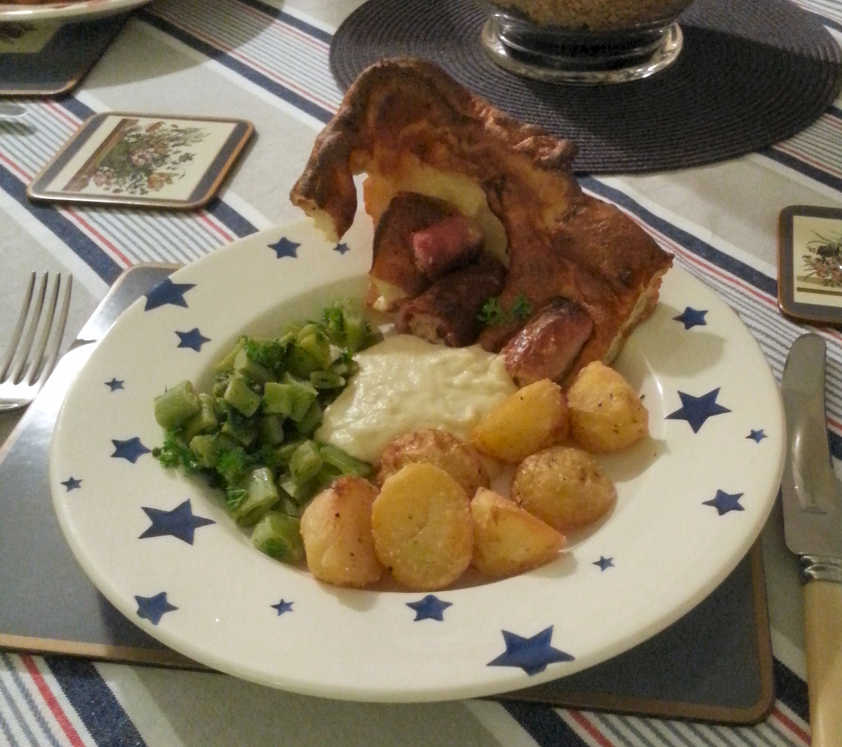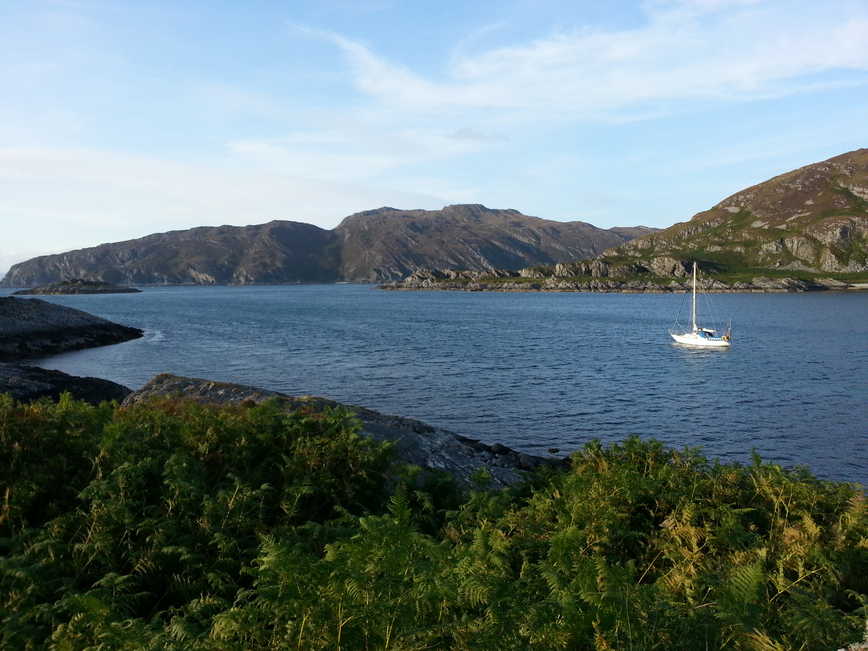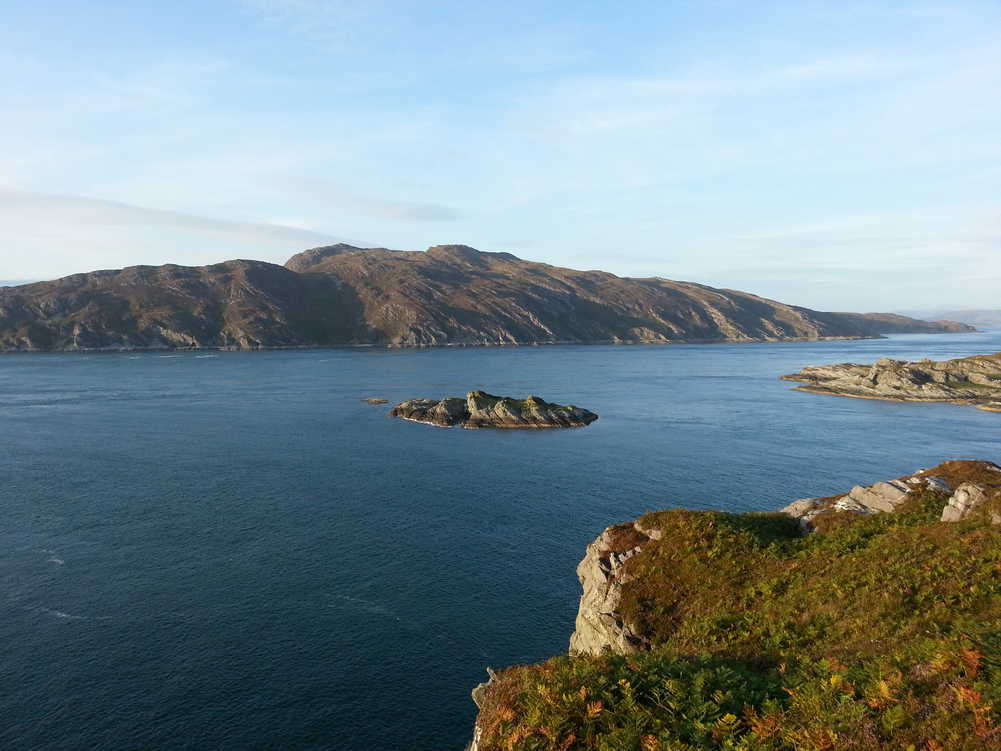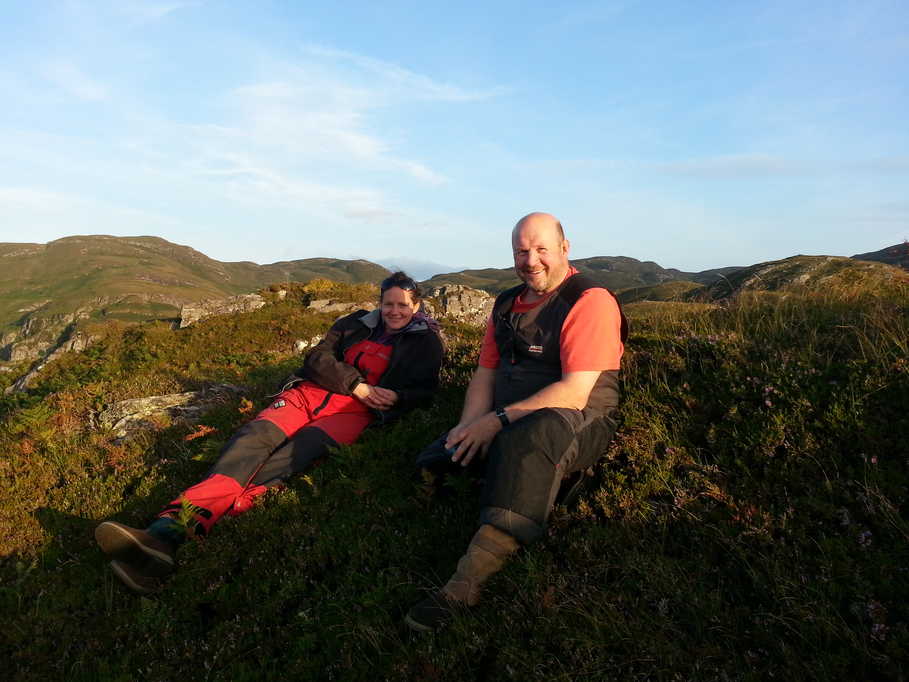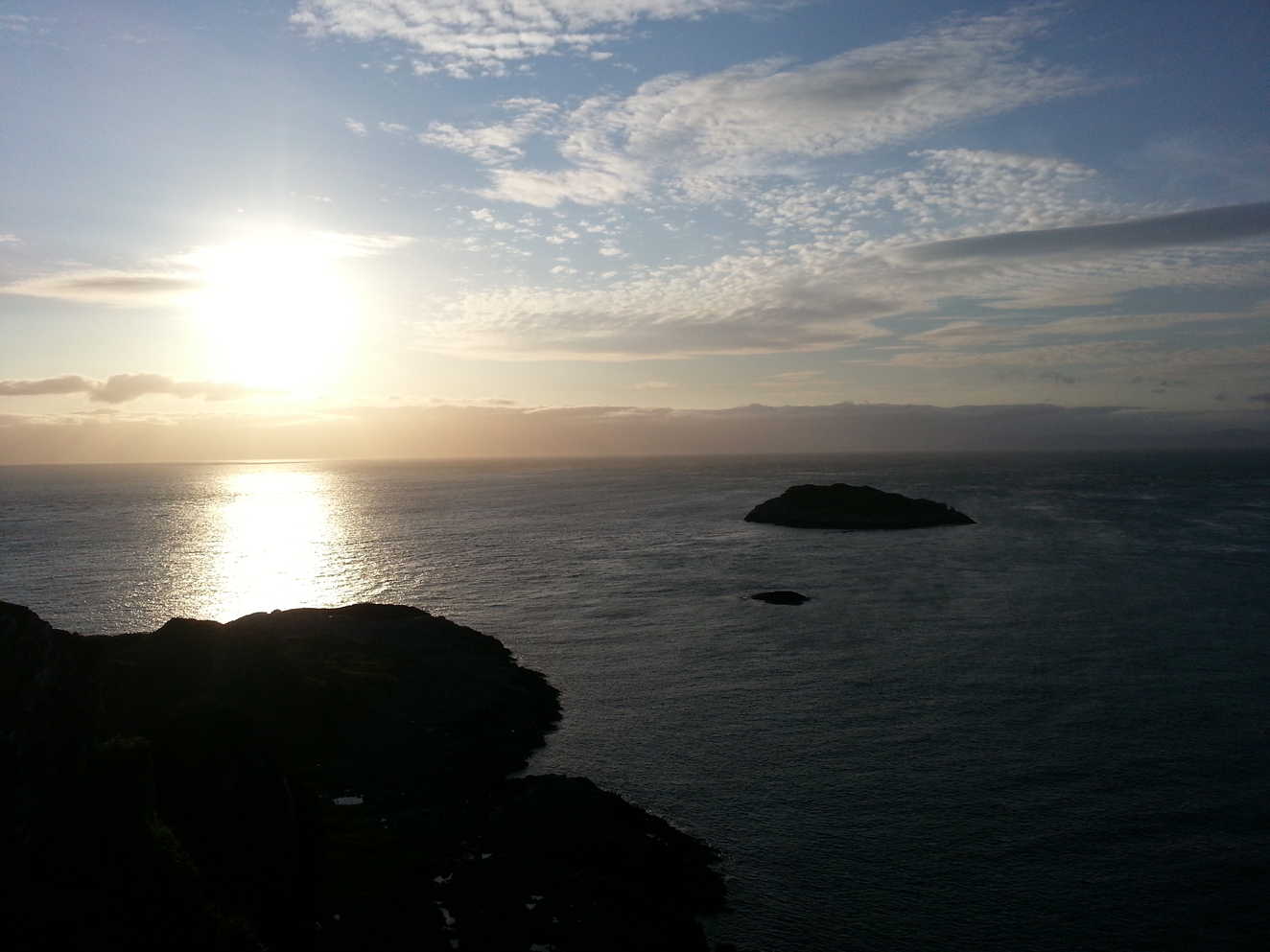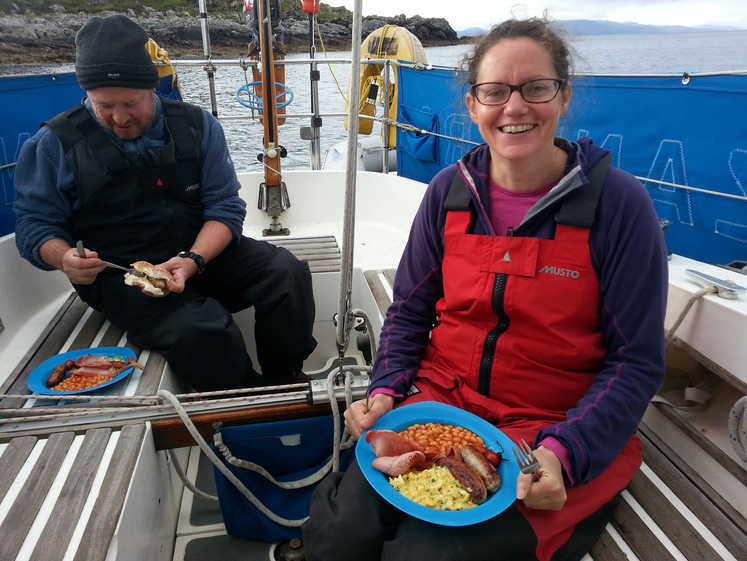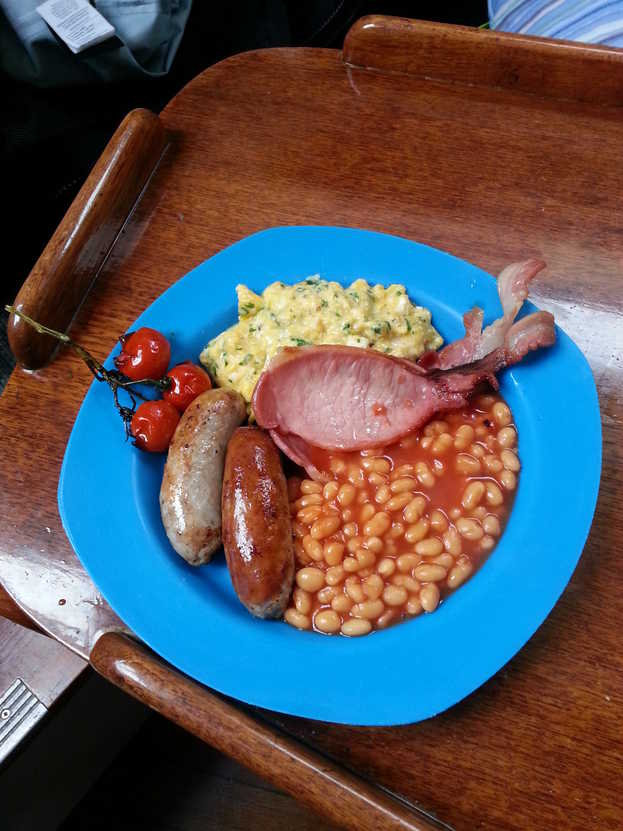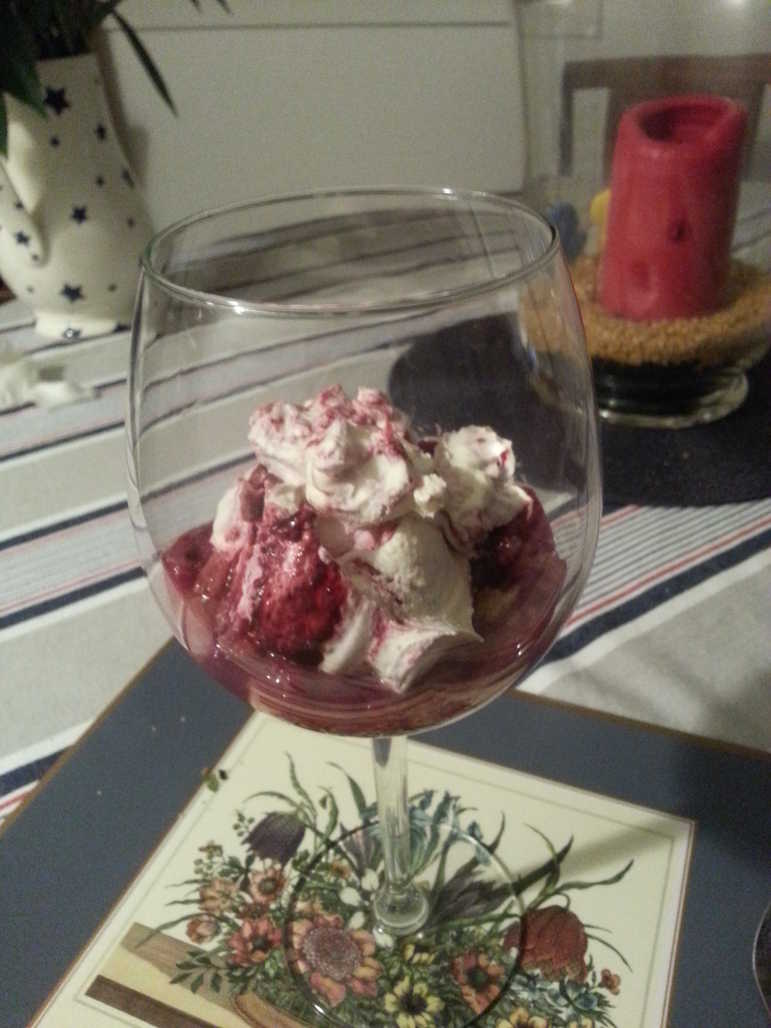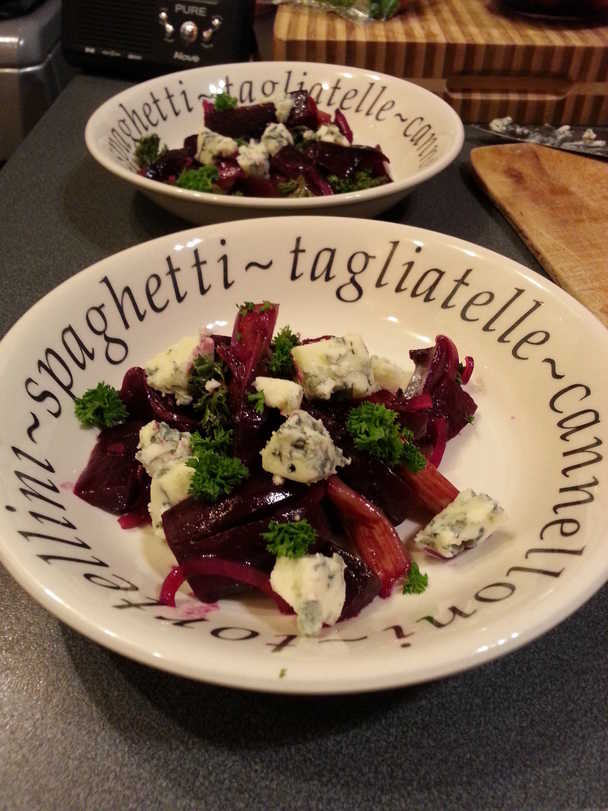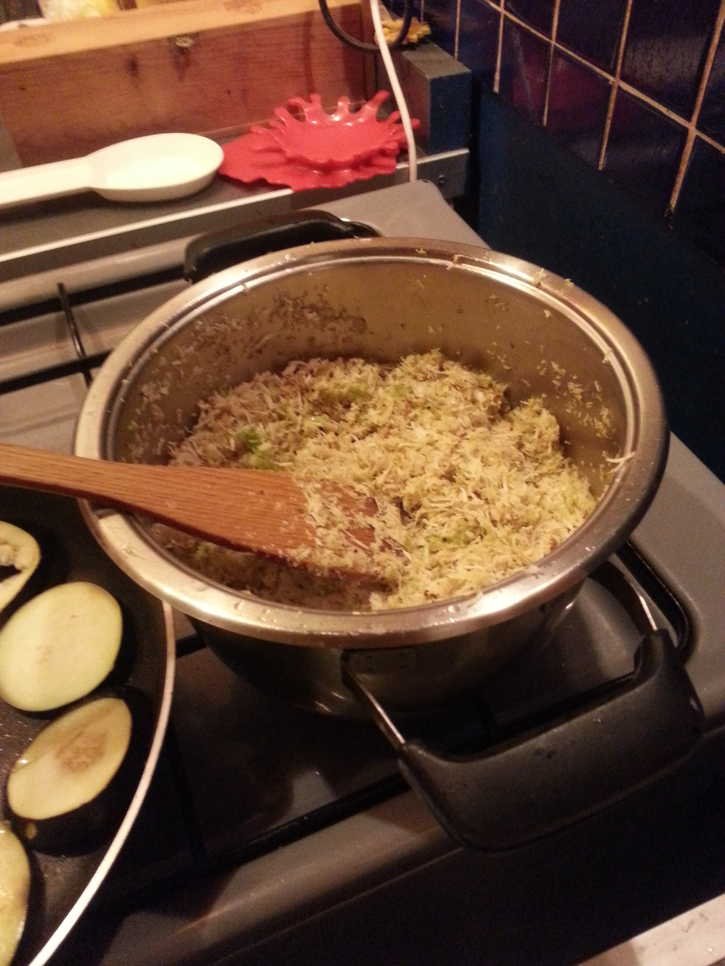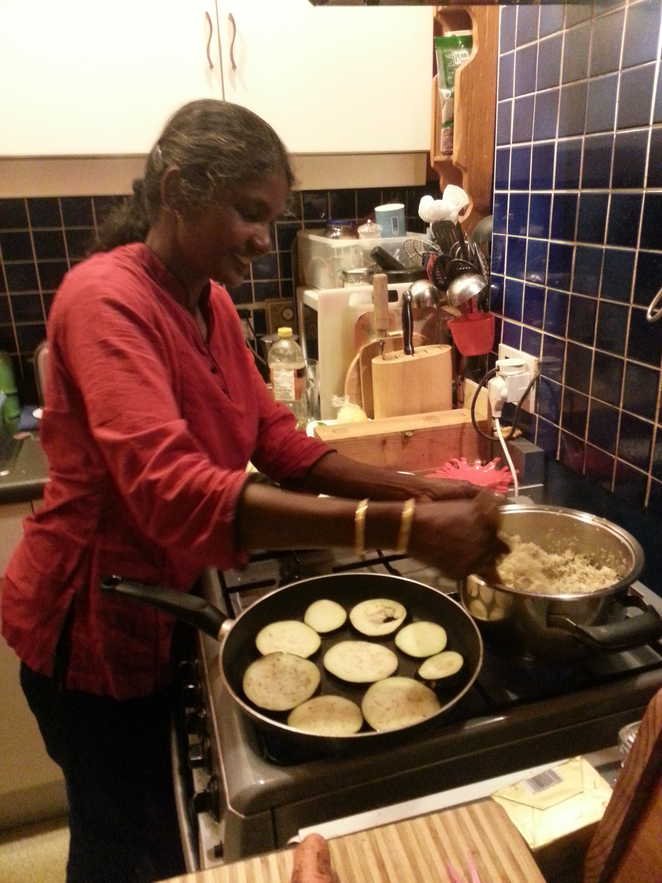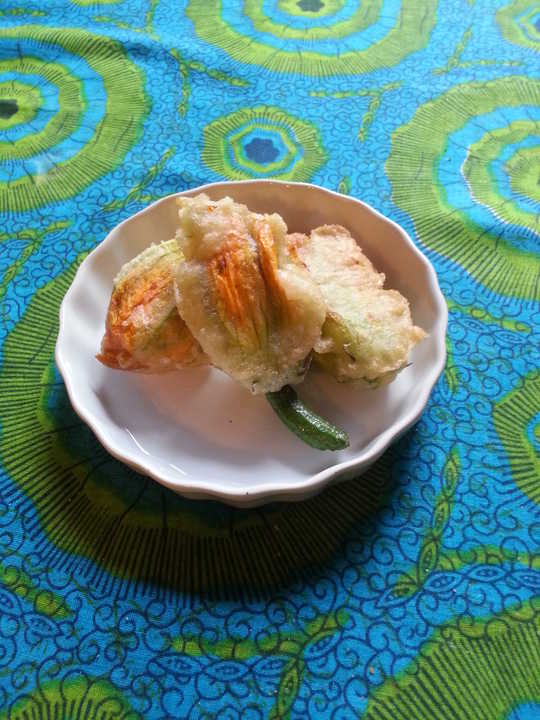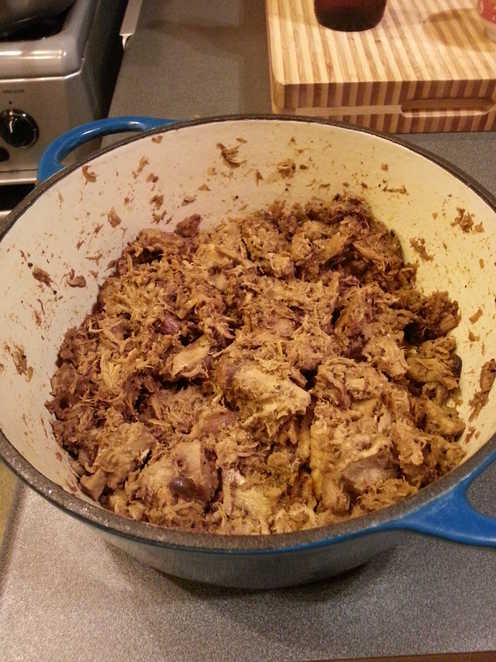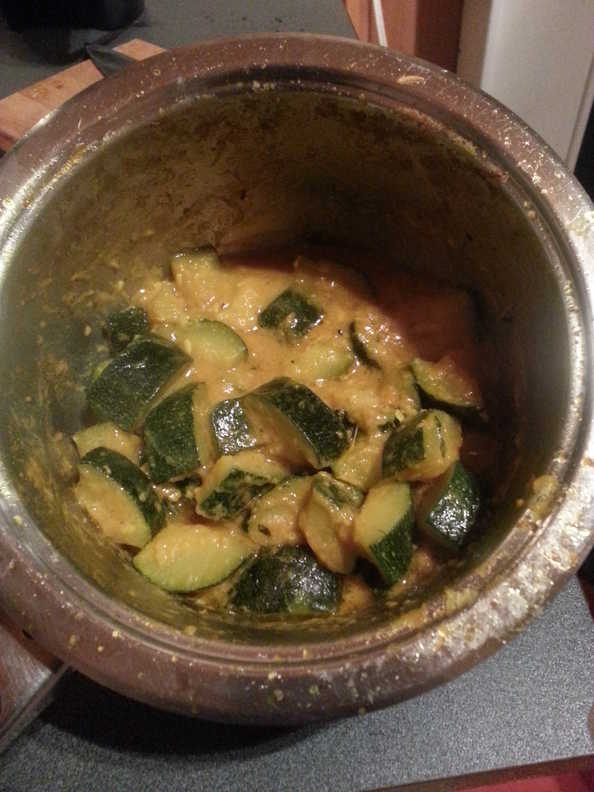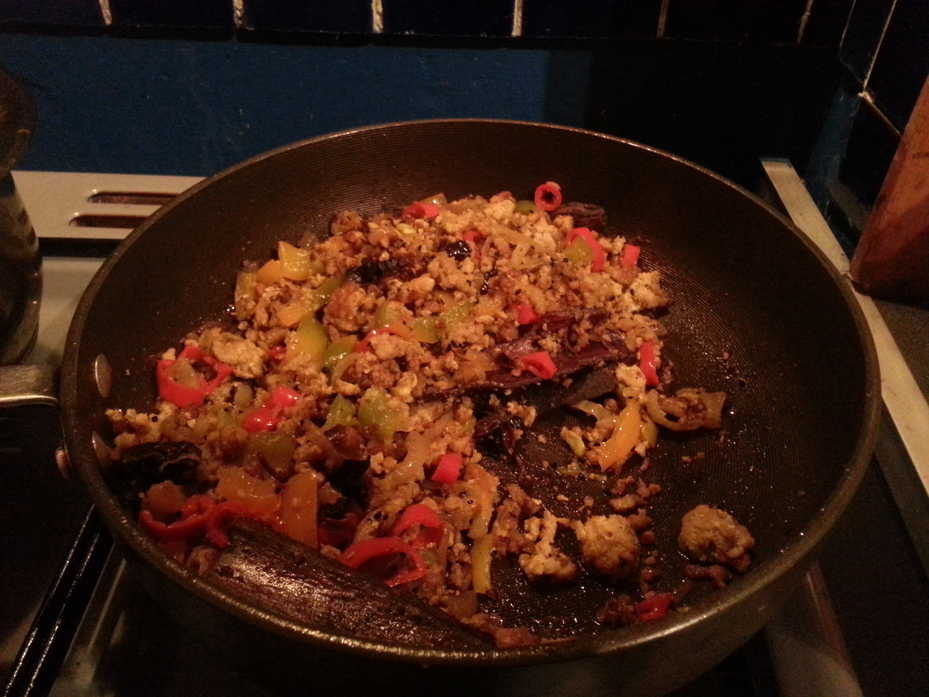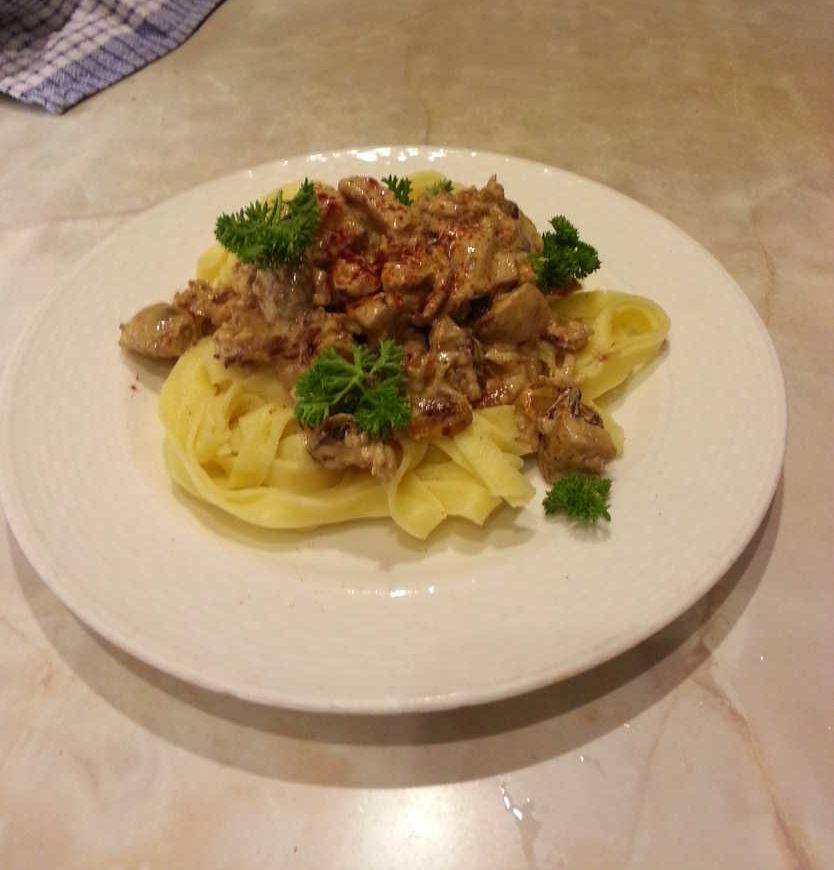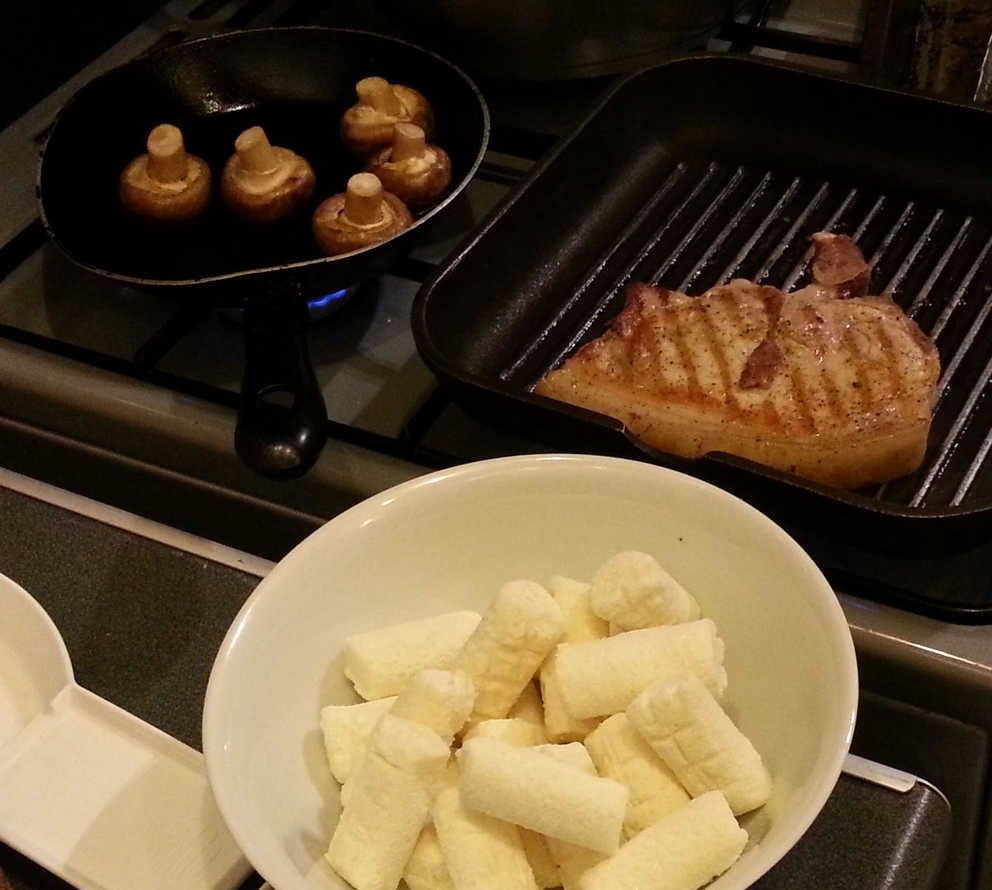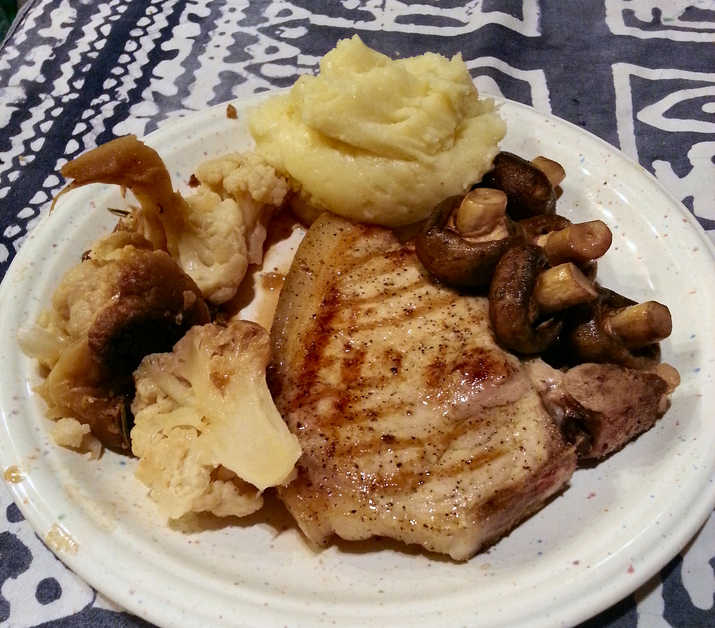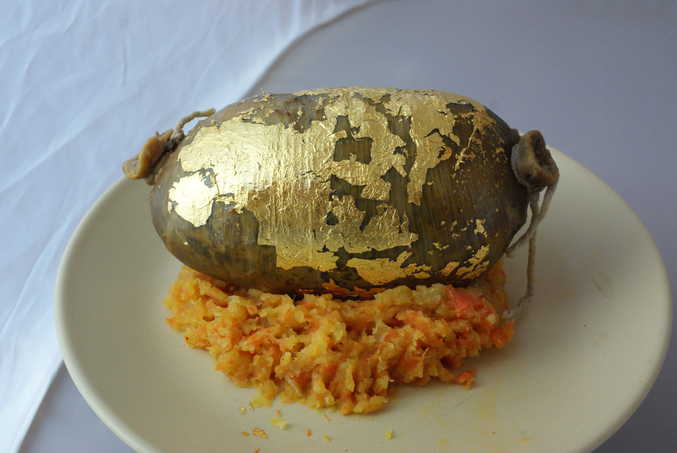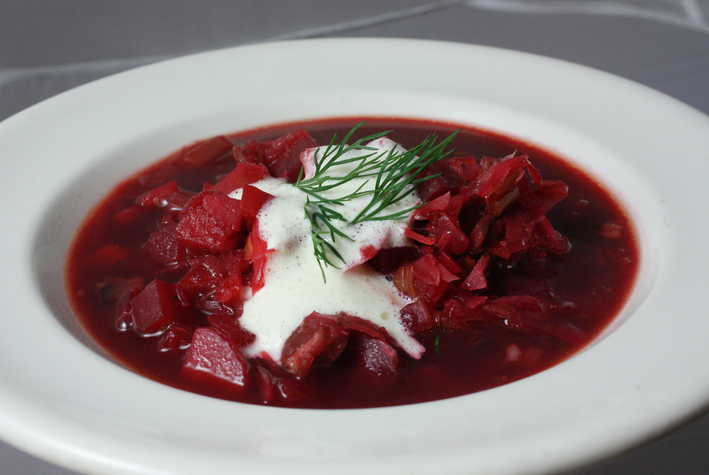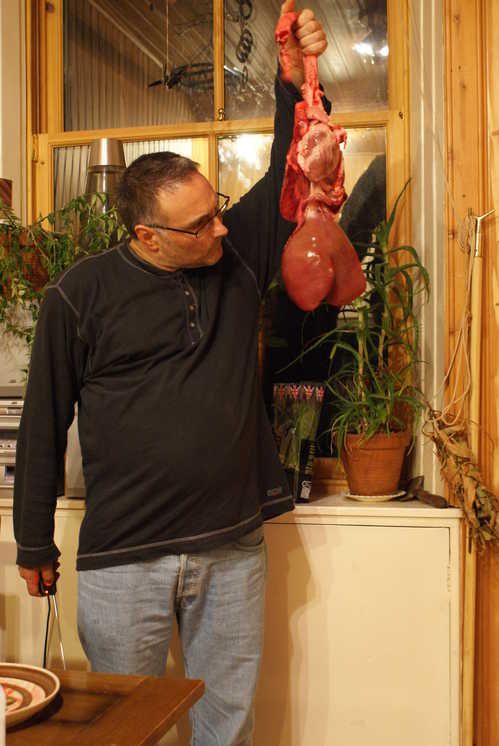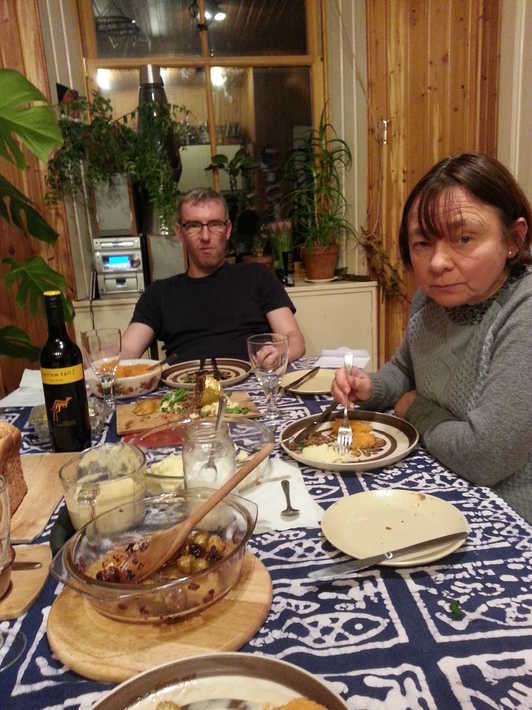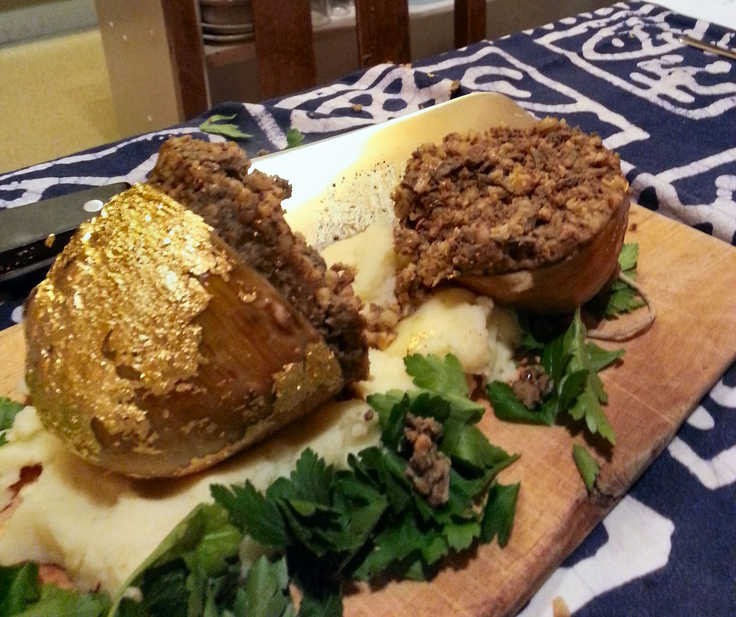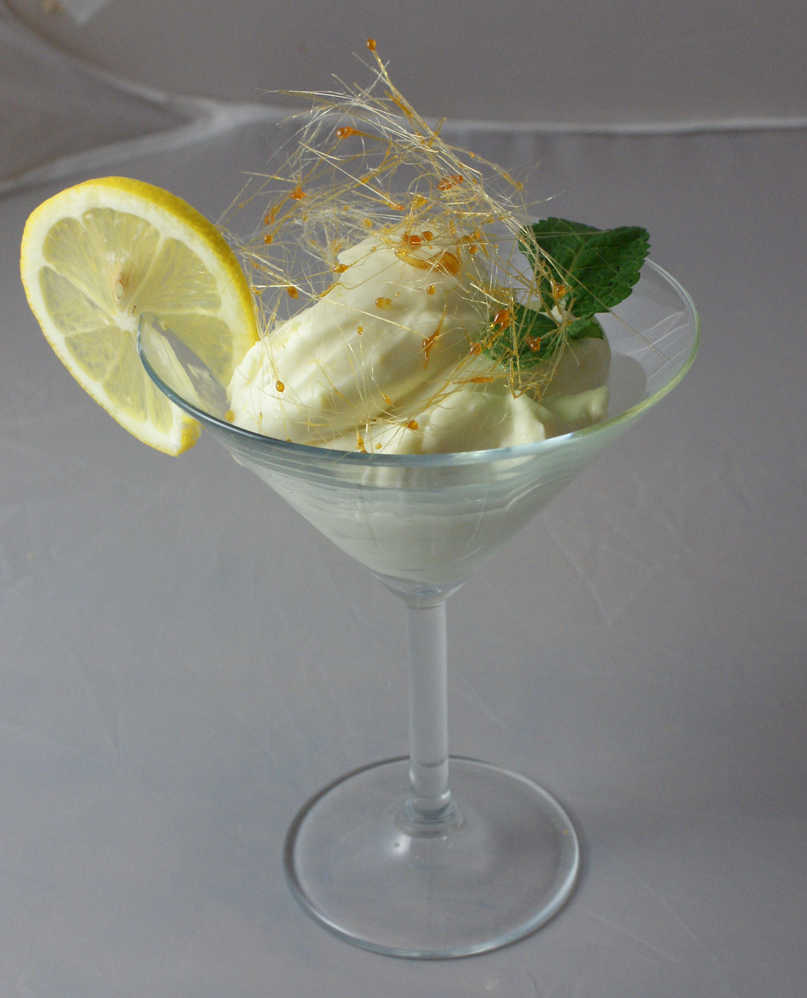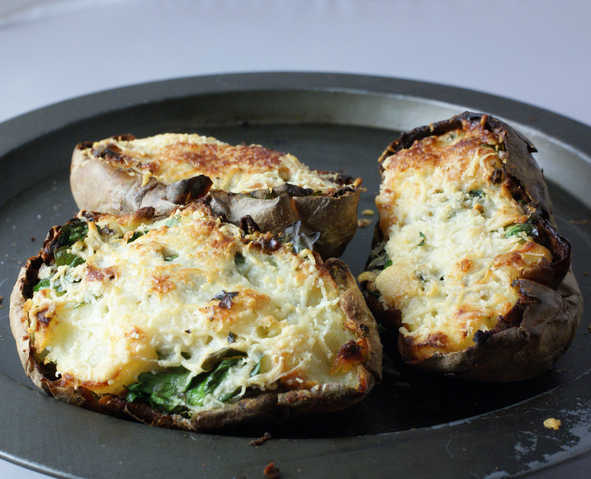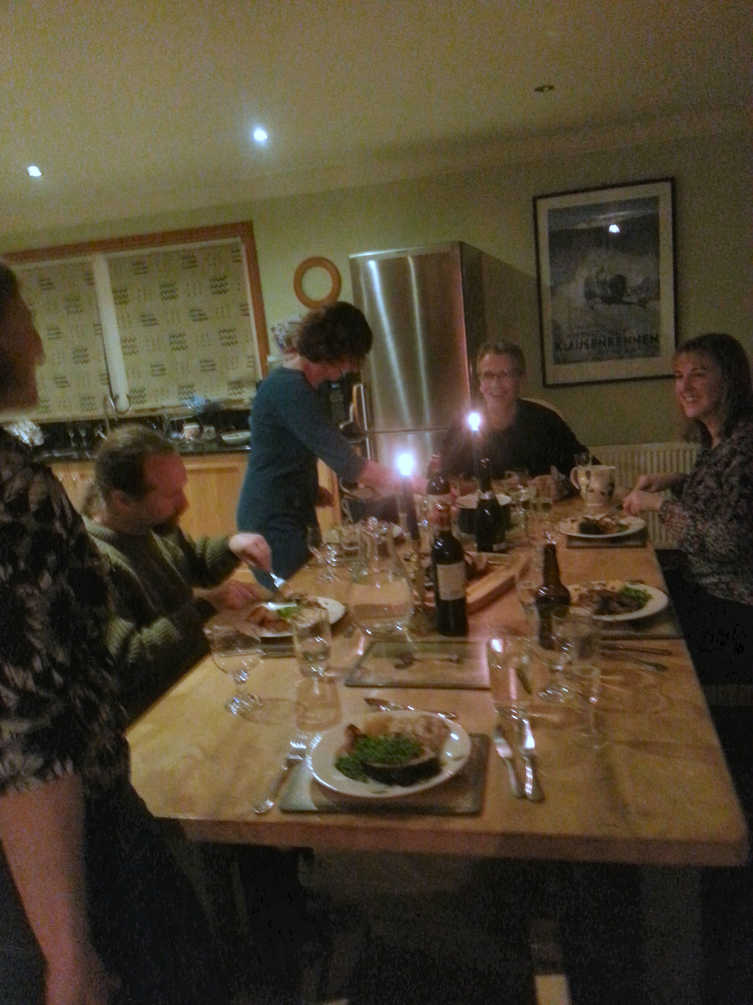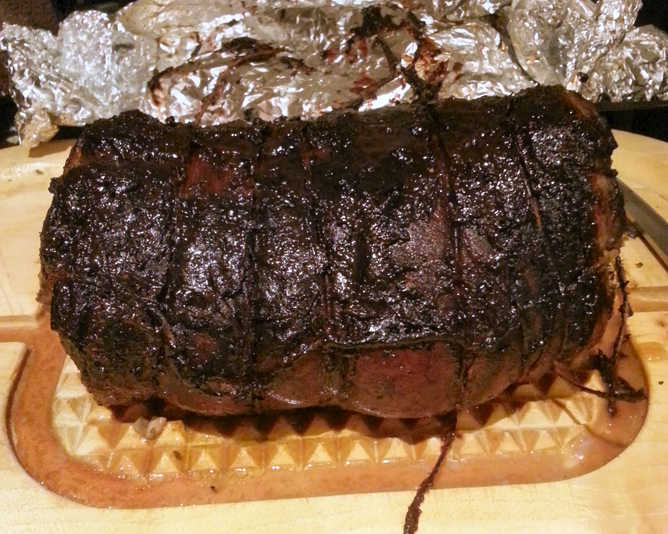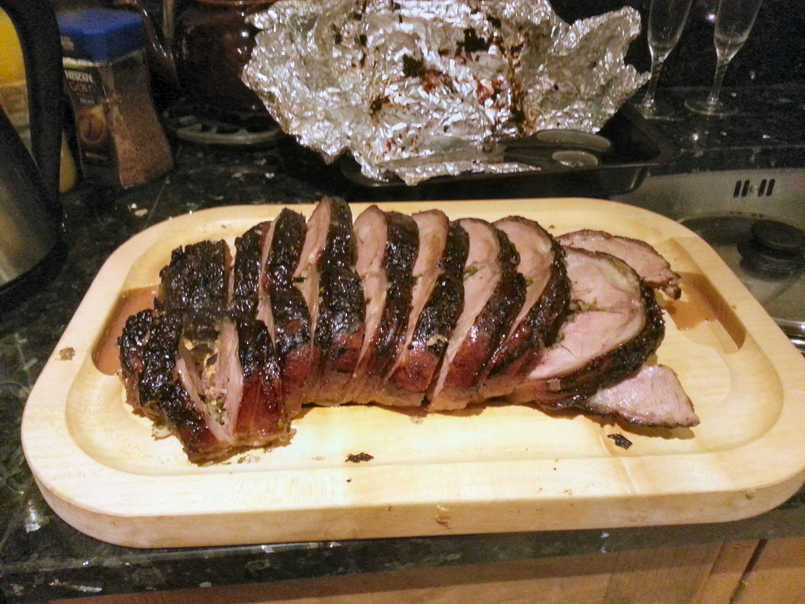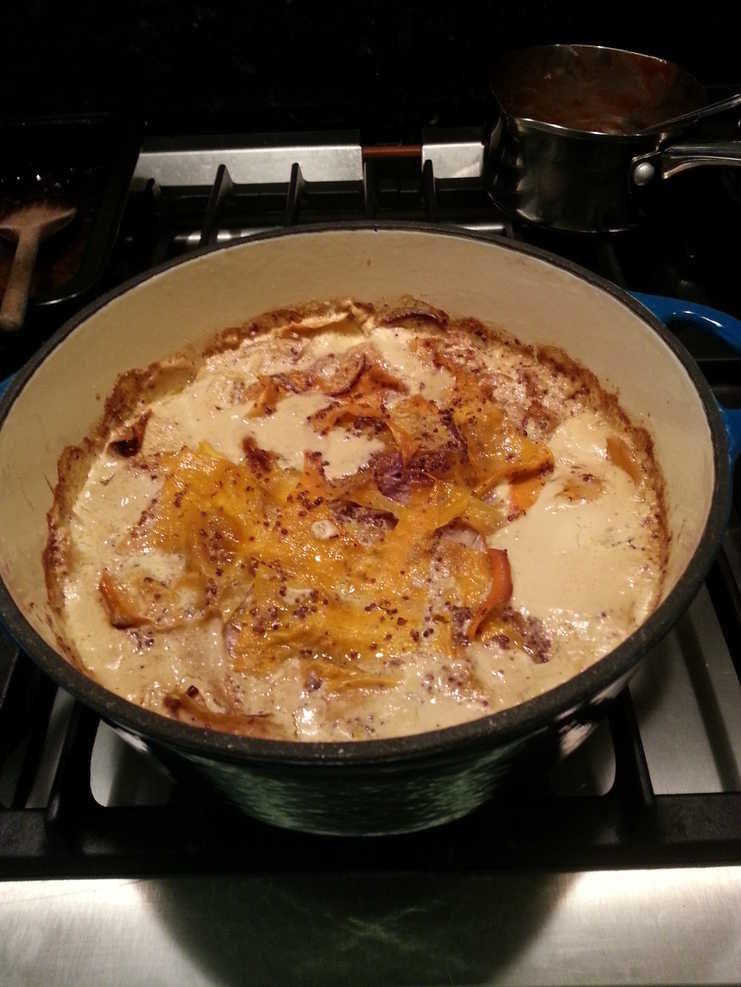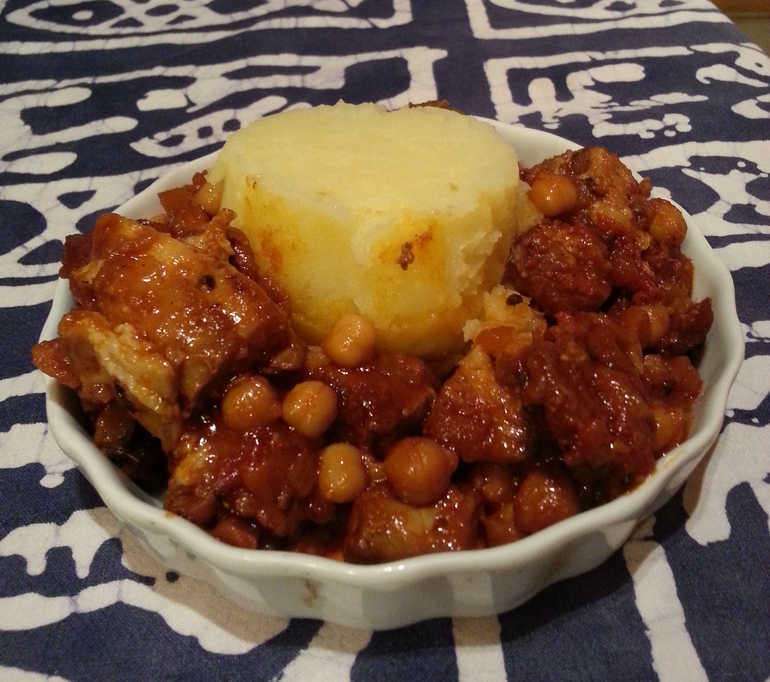
Flora In The Hole

Flora wants to expand her repertoire to include Toads in the Holes, so I consulted Nigel Slater for ideas for enhancing my Mum's traditional version such as by wrapping the sausages in fancy hams or adding splashes of mustard. We actually made a bit of an experiment of it and put a variety of sausages in the same hole - some plain, some skinned and wrapped in ham, and some in bacon.
We must have hit the Perla del Mar pretty hard though, 'cos I have little memory of the outcome - I think we agreed the bacon ones were the least good. I'm not sure if we thought the pancetta was a worthwhile faff. Perhaps Flora remembers?
I thought a creamy version of my apple-mustard sauce would make a good accompaniment hence no need to add mustard to the batter, together with roast potatoes and green beans.
Toad In The Hole
Sausage in Yorkshire pudding
meat main
Apparently
you get a tastier batter if you mix half milk and half beer, and a tablespoon of wholegrain mustard helps too.
It's almost universally agreed that you need to let the batter sit for (at least) 15 minutes before you use it. It should have the consistency of double cream - so adjust the liquid accordingly.
For a bit of variation you can skin the sausages and either turn them into little patties with the addition of herb or spices, or you can wrap the skinned sausages in ham or bacon before laying them in the batter. You might want to fry or roast the bacon-wrapped ones first, though.
It's almost universally agreed that you need to let the batter sit for (at least) 15 minutes before you use it. It should have the consistency of double cream - so adjust the liquid accordingly.
For a bit of variation you can skin the sausages and either turn them into little patties with the addition of herb or spices, or you can wrap the skinned sausages in ham or bacon before laying them in the batter. You might want to fry or roast the bacon-wrapped ones first, though.
Serves 4
Ingredients
- 2 eggs
- 125g flour
- 300ml milk or half-milk, half-ale
- 6 sausages
- 3 tablespoons dripping or lard
- thinly sliced prosciutto, Serrano ham, pancetta or thin streaky bacon optional
- 1 tbsp grainy mustard optional
- salt & pepper
Put the flour in a bowl and make a well in the centre. Whisk in the eggs and mustard if you like
and continue to whisk until just smooth. Gradually add the milk and a pinch of salt and whisk to a smooth batter.
The consistency should be that of double cream, but no thinner.
You might need to pour the batter through a strainer if it's still lumpy.
Leave to rest for at least 15 minutes.
Heat half the fat in a frying pan over a medium heat and brown the sausages on all sides.
Put the remaining fat in a roasting tin and leave it in the oven until it is smoking.
With the roasting tin sitting over a low heat pour in the hot fat from the sausage pan, followed by the batter - it will sizzle softly in the hot fat - then arrange the sausages in the batter.
Transfer the tin back into the oven and bake for 25-30 minutes until puffed and golden.
Traditionally served with peas and a rich onion and Madeira gravy.
Leave to rest for at least 15 minutes.
Heat half the fat in a frying pan over a medium heat and brown the sausages on all sides.
Or if you prefer, skin the sausages and wrap in the ham.
Preheat the oven to 220C/425F/Gas 7.Put the remaining fat in a roasting tin and leave it in the oven until it is smoking.
With the roasting tin sitting over a low heat pour in the hot fat from the sausage pan, followed by the batter - it will sizzle softly in the hot fat - then arrange the sausages in the batter.
Transfer the tin back into the oven and bake for 25-30 minutes until puffed and golden.
Traditionally served with peas and a rich onion and Madeira gravy.
Or you could try a chunky tomato sauce or even a creamy apple and mustard purée?
Creamy Apple and Mustard Purée
sauce veg
The perfect accompaniment to toad in the hole.
You're on your own with the quantities though :)
You're on your own with the quantities though :)
Ingredients
- butter
- onion, peeled, diced
- apple, cored, chopped
- a little brown sugar optional
- water or wine
- double cream
- Dijon mustard
Heat the butter in a saucepan and sweat some chopped onion, apple and sugar if using until soft.
Add a little water or wine and bubble until the apple collapses, then blend to a smooth paste or not if you prefer it chunky.
Return to the pan and stir in some cream, mustard and season to taste.
Add a little water or wine and bubble until the apple collapses, then blend to a smooth paste or not if you prefer it chunky.
Return to the pan and stir in some cream, mustard and season to taste.
Rather nice.
Avoid boiling once you've added the cream. You could always add some herbs (parsley, tarragon, chives) at the end if you like.
Avoid boiling once you've added the cream. You could always add some herbs (parsley, tarragon, chives) at the end if you like.
Rockin' The Vreckan

Yachtmistress Anna Whitewater offered a weekend on her boat the Zanzara in exchange for a flattering submission to Port Edgar Yacht Club's yearly cruising log competition.
And a cooked dinner.
I chose a delicious belly pork, chorizo and chickpea stew as the foody bribe. A good use of some lovely leftover hog roast stock too.
Ken Mud selflessly volunteered to author an entirely fictional log of our weekend - carefully censoring any mention of drink, drugs or nautical stupidity.
Anna was so impressed she agreed to take us through the notoriously deadly Corryvreckan.
Ancient mariners speak softly of the Corryvreckan and the sea monsters which lurk there - the whirlpools with their deadly currents eager to suck a boat to its water grave, the terrible storms which whip up in an instant and dash vessels to pieces on the cruel rocks, and the sunken wrecks waiting to snare unwary vessels seeking safe anchorage.
Fortunately none of those things are true.
Well, except for the last one, as we found out to our cost when we tried to raise our anchor after a very comfortable night in the beautifully sheltered bay just south of Oban with the unpronounceable name of Puilladobhrain (Pool of the Otter). Handy also for the famous Bridge over the Atlantic and nearby 18th century Tigh an Truish pub.
It seemed we'd hooked a heavy chain from an old fishing boat mooring and despite wrecking the anchor windlass succeeded in raising the anchor no more than a foot off the bottom.
After much straining and grunting (on my part), and swinging of the boat and chain (on Anna's part) Ken finally remembered that he had brought aboard a waterproof, submersible camera for just such occasions and he managed to lower it down to get pictures of the cause of our predicament.
Once understood it was just a matter of persuading Anna to dive into the freezing jellyfish-infested waters to hook a line through the mooring chain so we could tie it off and hold the massive links up while we dropped our anchor free of it. Then it would be just a matter of hauling up the anchor and its ludicrously heavy chain past the busted windlass and sailing off. Simples.
All power to the skipper - she took to the task like a seal, and we finally set off for the vreckan only 4 hours later than any possible calculations of the tides allowed for us to make it there in time.
The problem is, the tide flowing through the corryvreckan is so strong (8½ knots at springs, perhaps 4 knots at neaps) that there is no way to pass through against it, and our anchorage was Pig's Bay (Bagh nam Muc) just out the other side. Undaunted we pressed on - even hoisting the dusty spinnaker (to Anna's horror) to capture every last ounce of wind, and surprised ourselves by arriving at the very slackest of the tide.
So much for our calculations!
As we motored through the gulf the tide beneath us swung madly between 2 knots with us to 2 knots against us, it was a little nerve-racking but we made it through.
So safe and sound for another night at anchor, a row ashore, and a knotty clamber to a fine view of the whirlpools, which are real. After a Karl Special breakfast, a gentle sail saw us back to Oban the next day and apologies to Anna's dad for wrecking the windlass and snapping the dinghy oar.
Well, at least Ken didn't set the outboard on fire this time!
Belly Pork, Chorizo and Chickpea Casserole
main meat nautical stew
An extremely rich stew, that freezes well too.
Perfect for provisioning a boat trip!
Perfect for provisioning a boat trip!
Serves 4
Ingredients
- 1 tbsp olive oil
- 700g skinless, boneless pork belly, cut into large bite-sized chunks
- 100g cooking chorizo, sliced into thin rounds or more
- 1 large onion, roughly chopped
- 1 large carrot, cut into fat cubes
- 1-2 tsp fennel seed
- small pinch dried chilli flakes optional
- 4 garlic cloves, roughly chopped
- 4 bay leaves, fresh are best
- sprig of thyme
- large pinch golden caster sugar
- 2-3 teaspoons paprika
- 1 tbsp tomato purée
- 50ml sherry vinegar or good quality red wine vinegar
- 50ml sherry
- 400g tin chopped tomatoes
- 400ml pork stock
- 400g tin chickpeas or other beans e.g. butter, drained and rinsed
- fresh chopped parsley
Heat the oven to 160C/140C fan/gas 3.
Heat the oil in a casserole dish with a lid and fry the fennel seeds until sizzling.
Add the belly pork and spend a good 10 mins browning the pork on all sides in batches, scooping it out to set aside as it's done.
Next fry the chorizo and sizzle for a minute. Scoop out and add to the pork.
Add the carrots, then chilli flakes, then onion, then herbs and cook for about 5 mins until the vegetables are soft and just starting to colour.
Sprinkle over the sugar, add the garlic and paprika and cook a little.
Stir in the tomato purée then splash in the sherry and the vinegar and bubble for a moment.
Tip in the tomatoes and a can of pork stock (say, from a hog roast carcass) or water. Stir the meat and juices into the sauce, season with salt and pepper and bring to a simmer.
Cover the dish with a lid and place in the oven for 2 hours, checking occasionally and if the sauce becomes too thick add a splash more stock. Remove the pan from the oven and stir in the chickpeas and return to the oven for 15 mins. Remove again and leave to cool slightly so it's not scorching hot then stir through the parsley. Taste for seasoning and serve with crusty bread or boiled or mashed potatoes.
Heat the oil in a casserole dish with a lid and fry the fennel seeds until sizzling.
Add the belly pork and spend a good 10 mins browning the pork on all sides in batches, scooping it out to set aside as it's done.
Next fry the chorizo and sizzle for a minute. Scoop out and add to the pork.
Add the carrots, then chilli flakes, then onion, then herbs and cook for about 5 mins until the vegetables are soft and just starting to colour.
Sprinkle over the sugar, add the garlic and paprika and cook a little.
Stir in the tomato purée then splash in the sherry and the vinegar and bubble for a moment.
Tip in the tomatoes and a can of pork stock (say, from a hog roast carcass) or water. Stir the meat and juices into the sauce, season with salt and pepper and bring to a simmer.
Cover the dish with a lid and place in the oven for 2 hours, checking occasionally and if the sauce becomes too thick add a splash more stock. Remove the pan from the oven and stir in the chickpeas and return to the oven for 15 mins. Remove again and leave to cool slightly so it's not scorching hot then stir through the parsley. Taste for seasoning and serve with crusty bread or boiled or mashed potatoes.
Delicious.
If you're going to use dried beans, soak them overnight then cook them for an hour until al dente before adding to the casserole for cooking in the oven.
Our Allotted Vegetables

My neighbour Nancy and her allotment keep me well supplied with vegetables. And the occasional fruit. Thanks Nancy!
Since her glut of beetroot and rhubarb, I've been inventing things to do with beetroot and rhubarb. And carrots.
Getting some courgette flowers to stuff made a nice change.
Rhubarb and Beetroot Fool
dessert veg
Yes that's right - a rhubarb and beetroot fool!
Partly because I had a lot of beetroot and rhubarb to eat up, partly because it seemed like they might just work together, partly just 'cos they were there...
Partly because I had a lot of beetroot and rhubarb to eat up, partly because it seemed like they might just work together, partly just 'cos they were there...
Serves 4
Ingredients
- fresh ginger optional
- 4 sticks rhubarb
- 1 beetroot
- berry coulis say blackberries and blackcurrants
- double cream
Heat the oven to 180-200°C, put the whole unpeeled beetroot on an oven tray and bake until it is soft and easily pierced with a knife (up to 2 hours).
Roughly chop the rhubarb, scatter with a little sugar (perhaps a dessertspoon), moisten with a little apple juice, liquor or water and cook gently in a covered pot until the rhubarb begins to collapse. Check the sugar level and set aside to cool.
Whip the cream until it begins to thicken, but is still pourable. Peel and finely grate the beetroot and mix with the rhubarb. Lightly stir together the cream and rhubarb mixture (so they form distinct swirls) and serve with a drizzle of fruit coulis.
Roughly chop the rhubarb, scatter with a little sugar (perhaps a dessertspoon), moisten with a little apple juice, liquor or water and cook gently in a covered pot until the rhubarb begins to collapse. Check the sugar level and set aside to cool.
Whip the cream until it begins to thicken, but is still pourable. Peel and finely grate the beetroot and mix with the rhubarb. Lightly stir together the cream and rhubarb mixture (so they form distinct swirls) and serve with a drizzle of fruit coulis.
You know what, it ain't bad! It's a more earthy, nutty concoction than pure rhubarb, but less aggressively acidic.
I planned on adding some grated ginger to the rhubarb, but I forgot. I still think it might be nice though.
Also since beetroot goes well with chocolate - consider a chocolate sauce instead of the coulis?
I planned on adding some grated ginger to the rhubarb, but I forgot. I still think it might be nice though.
Also since beetroot goes well with chocolate - consider a chocolate sauce instead of the coulis?
Beetroot and Rhubarb Salad
salad veg cheese
My neighbour Nancy had a glut of beetroot and rhubarb in her allotment this year. So I thought I'd try ways of combining them.
This is Yotam Ottolenghi's idea, and I think it works better than my fool. But you could always have a meal with both!
The dressing proved so good I gave it a recipe all of its own.
The dressing proved so good I gave it a recipe all of its own.
Serves 4
Ingredients
- 800g various beetroots (or, if you can't get them, one type is fine)
- 300g rhubarb, cut on an angle into 2.5cm pieces
- 30g caster sugar
- 1 small red onion, thinly sliced
- 20g picked parsley leaves
- 100g creamy Gorgonzola or similar blue cheese, torn into small chunks
- salt and black pepper
Dressing:- 2 tsp sherry vinegar
- ¾ tbsp pomegranate molasses
- 2 tbsp maple syrup
- 2 tbsp olive oil
- ½ tsp ground allspice (pimento)
- a handful of pomegranate seeds optional
Set the oven to 200C/400F/gas mark 6. Wrap the beets individually in foil and bake for 40-70 minutes, depending on size.
To check, push a sharp knife through to the centre of each one - it should be soft all the way through.
Set aside to cool, then peel and cut into a rough 2cm dice.
Toss the rhubarb with the sugar, spread it over a foil-lined oven tray and roast for 10-12 minutes, until soft but not mushy. Set aside to cool.
In a large bowl, whisk the vinegar, molasses, maple syrup, oil, allspice and some salt and pepper. Add the onion, set aside for a few minutes to soften, then add the parsley and beets. Stir to combine, season to taste and, just before serving, gently fold in the rhubarb, its juices and the cheese.
Toss the rhubarb with the sugar, spread it over a foil-lined oven tray and roast for 10-12 minutes, until soft but not mushy. Set aside to cool.
In a large bowl, whisk the vinegar, molasses, maple syrup, oil, allspice and some salt and pepper. Add the onion, set aside for a few minutes to soften, then add the parsley and beets. Stir to combine, season to taste and, just before serving, gently fold in the rhubarb, its juices and the cheese.
Really quite tasty. The cheese ties the whole thing together very nicely.
It will look better if you hold the (curly) parsley and the cheese back to the end so they look clean and perky.
I thought it could also do with more rhubarb, perhaps double, so you end up with roughly equal quantities of beetroot and rhubarb. I also wondered if a hint of sumac might go quite well?
It will look better if you hold the (curly) parsley and the cheese back to the end so they look clean and perky.
I thought it could also do with more rhubarb, perhaps double, so you end up with roughly equal quantities of beetroot and rhubarb. I also wondered if a hint of sumac might go quite well?
Beetroot and Carrot Poriyal
curry veg vegan side
So this dish went a bit wrong - I shaved the coconut using a vegetable peeler along the coconut edge,
due to the following confusing suggestions of my cute landlady Aline:
Aline: You don't have a coconut shaver do you? My friend from Kerala made a really nice cabbage thoran with shaved fresh coconut
Karl: No I don't think so - is it like a cheese grater?
Aline: No, it shaves the coconut from the inside - it's nothing like a cheese grater. I don't think you could use a cheese grater
Karl: Oh, that sounds good - I'll try it with some of Nancy's carrots and beetroots
...
Karl: What do you think of my carrot and beetroot poriyal [a dish from Tamil Nadu, next door to Kerala] with shaved coconut?
Aline: The coconut is thick and hard - why didn't you grate it with the cheese grater? You should have used the cheese grater
Karl: ??!!??
Karl: No I don't think so - is it like a cheese grater?
Aline: No, it shaves the coconut from the inside - it's nothing like a cheese grater. I don't think you could use a cheese grater
Karl: Oh, that sounds good - I'll try it with some of Nancy's carrots and beetroots
...
Karl: What do you think of my carrot and beetroot poriyal [a dish from Tamil Nadu, next door to Kerala] with shaved coconut?
Aline: The coconut is thick and hard - why didn't you grate it with the cheese grater? You should have used the cheese grater
Karl: ??!!??
Serves 2-3
Ingredients
- 2 medium beetroots
- 1 medium carrot
- 1 green chili, chopped
- 1 tsp urad dal
- 1 tsp mustard
- 1 tsp fenugreek seeds
- 1 green chili
- 10-12 curry leaves/kadi patta
- a pinch of asafoetida/hing
- a pinch of turmeric/haldi
- 1 tbsp oil
- 3-4 tbsp shaved coconut shaved is Indian for grated apparently
- salt as required
Rinse, peel and chop the beetroots and carrot very finely, the more fine, they faster they will cook.
You can also grate the veggies if you prefer.
Fry till the mustard seed make a popping sound and the urad dal get maroonish golden. make sure you don't burn them.
Add the green chilies, curry leaves, turmeric powder and asafoetida. Fry for 10-12 seconds.
Now add the chopped veggies. sprinkle salt and stir. Cover and let the veggies cook till they are done. Sprinkle some water if the moisture dries in the pan. Keep on checking during intervals and sprinkle water whenever required.
When the veggies are cooked well, lastly add coconut and give a stir. Before adding the coconut, if there is moisture in the pan, then dry it by simmering on an open flame for a few minutes. Sprinkle the coconut and then switch off the flame and cover.
Actually I cut mine a bit chunky 'cos I was expecting the coconut to be quite thick too, but with grated coconut I can see the point now...
Heat the oil in a pan. Add the mustard seeds and urad dal.Fry till the mustard seed make a popping sound and the urad dal get maroonish golden. make sure you don't burn them.
Add the green chilies, curry leaves, turmeric powder and asafoetida. Fry for 10-12 seconds.
Now add the chopped veggies. sprinkle salt and stir. Cover and let the veggies cook till they are done. Sprinkle some water if the moisture dries in the pan. Keep on checking during intervals and sprinkle water whenever required.
When the veggies are cooked well, lastly add coconut and give a stir. Before adding the coconut, if there is moisture in the pan, then dry it by simmering on an open flame for a few minutes. Sprinkle the coconut and then switch off the flame and cover.
Bit dull - I'm sure it could be improved.
Perhaps by grating the coconut?
Cabbage Thoran
curry veg vegan side
So here's the very nice Cabbage Thoran that Aline's friend Laly from Kerala made.
If you have a coconut shaving tool, now's the time to dust it off. Otherwise use a fine cheese grater.
If you have a coconut shaving tool, now's the time to dust it off. Otherwise use a fine cheese grater.
Serves 4
Ingredients
- oil for frying
- 1 cabbage, finely grated
- ½ coconut, finely grated
- 2 tsp mustard seeds
- ½ onion, roughly chopped
- ginger, grated
- 1 tsp turmeric optional
- fresh green chillies, chopped
Crack open the coconut, remove the brown skin with a vegetable peeler (though you can eat it), and finely grate the white flesh.
Add the roughly chopped onion and fry over high heat until they are quite browned around the edges.
Add the turmeric, if using.
Add the grated cabbage, grated coconut, grated ginger, chopped chilli and a little salt, cover, lower heat and leave to steam stirring occasionally until cooked through (20-30 minutes).
You can do this by punching holes in the coconut eyes, draining the water,
putting the coconut briefly in a very hot oven and tapping with a hammer. Or waiting until the shell cracks with the heat.
Or cutting it in half with a machete.
Beware that the heating might evaporate a little of the moisture and natural oils from the coconut flesh.
Heat the oil and fry the mustard seeds until they pop.Or cutting it in half with a machete.
Beware that the heating might evaporate a little of the moisture and natural oils from the coconut flesh.
Add the roughly chopped onion and fry over high heat until they are quite browned around the edges.
Add the turmeric, if using.
Add the grated cabbage, grated coconut, grated ginger, chopped chilli and a little salt, cover, lower heat and leave to steam stirring occasionally until cooked through (20-30 minutes).
Subtle, gentle but tasty.
It's quite dry - Aline reckons it was bad coconut, or bad grating - so needs serving with a moist dish. I'd probably prefer less coconut than Laly does.
It's quite dry - Aline reckons it was bad coconut, or bad grating - so needs serving with a moist dish. I'd probably prefer less coconut than Laly does.
Stuffed Courgette Flowers
starter snack veg cheese
The male flowers may have a short stalk on them, but the females can have small courgettes attached.
It's difficult, though, to cook flower and the attached courgette the right amount, so attractive as they may be,
probably better just to cook the flower.
If you're serving lactose intolerants you can probably work up something of the right stuffing consistency with yoghurt and some kind of tofu.
If you're serving lactose intolerants you can probably work up something of the right stuffing consistency with yoghurt and some kind of tofu.
Ingredients
- courgette flowers
- soft cheese (cream/ricotta/goat's)
- a little hard cheese, grated optional
- herbs, chopped
- lemon zest
- flour and egg, milk or water batter mixture
Carefully open up the flowers, check for bugs, and pinch out the stem at the base of the flower.
Give them a clean if necessary.
Mix your chosen soft cheeses with some chopped herbs (basil, parsley, mint, etc), a grating of stronger cheese like Parmesan or hard goat's cheese and grate in some lemon zest. Spoon the mixture into the flowers, then fold them back up giving a little twist at the tips to hold them closed.
Make a light batter - I like a tempura-style version with 50/50 regular flour (or rice flour) and cornflour with a sprinkling of bicarbonate of soda and a pinch of salt, mixed to the consistency of thick cream with really cold sparkling water. Heat half an inch or so of oil in a pan. Roll the flowers in the batter to coat them lightly, then fry quickly in the hot oil, turning to make them golden all over. If the filling starts to ooze out it's a sign they're done.
Mix your chosen soft cheeses with some chopped herbs (basil, parsley, mint, etc), a grating of stronger cheese like Parmesan or hard goat's cheese and grate in some lemon zest. Spoon the mixture into the flowers, then fold them back up giving a little twist at the tips to hold them closed.
Make a light batter - I like a tempura-style version with 50/50 regular flour (or rice flour) and cornflour with a sprinkling of bicarbonate of soda and a pinch of salt, mixed to the consistency of thick cream with really cold sparkling water. Heat half an inch or so of oil in a pan. Roll the flowers in the batter to coat them lightly, then fry quickly in the hot oil, turning to make them golden all over. If the filling starts to ooze out it's a sign they're done.
Very nice indeed, and pretty too.
Good served with a tomato sauce or tomato vinaigrette
Good served with a tomato sauce or tomato vinaigrette
Hog!

I make this entry under protest so that my fellow code-monkey The Cave Bague can get my recipe for hog roast vindaloo. Some day soon I'll fill in all the other missing holes in my diary, but until then here's one hole filled at least...
So it started with East Coast Sailing Festival at Port Edgar, and four days of stiff sailing competition in which we managed both a couple of first places and at least one last. On Saturday night though, the entertainment committee arranged for a hog roast (together with the usual beer tent and ethnic dance music), and having paid a ludicrous five pounds for a tinder-dry hog-roast-roll and missing out on the cut-price £2.50 clearance at the end of the night, I asked the nice hog roast man what he intended doing with the leftover carcass.
Since it seemed a pity to let him give it away to a kennel I asked if I could have it for stock and he kindly filled a binliner with the bones and more than a little leftover wads of meat still attached. Much to the boat skipper's horror when he came to poke around in the fridge onboard next morning!
After stripping down the bones and roasting them to make a deliciously rich pork stock I had enough meat (plus fat and the odd bit of gristle) to knock up a hog roast stroganoff for four to see us through the annual fireworks concert marking the finale of the Fringe Festival, as seen from the fantastic vantage point of the top floor bedrooms of Flora's family home (thanks Flora!). And an excellent vindaloo to go with the two other curries I already had standing by.
Hopefully this'll stop yer moaning John :)
Peace.
Hog Roast Vindaloo
Pork
meat curry main
When the Portuguese arrived in Goa they brought with them barrels of pork preserved in red wine vinegar and garlic for the making of
Carne de Vinha d'Alhos,
eventually adapting this pork adobo to the local ingredients by pickling in fermented palm wine vinegar, sweetening with jaggery,
adding Indian spices: tamarind, sumac (surprisingly), cassia, cardamom, and of course absorbing a large amount of red chilli.
And renaming it Vindaloo.
Obviously the recipe became further bastardised by the British restaurant trade which gradually eroded it's distinctive vinegar and garlic flavours, made it hotter than the sun, and began adulterating it with tomatoes and potatoes.
This recipe is a throwback to the earlier version - though you can of course make it as hot as you can bear. Or hotter.
It just so happened that my yacht club had a hog roast one of the days it hosted East Coast Sailing Festival, so I begged the carcass afterwards, which they would otherwise have given to a dogs' home. I made an excellent stock from the bones, and stripped off enough good hog flesh to make this vindaloo.
And a stroganoff.
And a few pork sandwiches.
And a nice cardigan.
Obviously the recipe became further bastardised by the British restaurant trade which gradually eroded it's distinctive vinegar and garlic flavours, made it hotter than the sun, and began adulterating it with tomatoes and potatoes.
This recipe is a throwback to the earlier version - though you can of course make it as hot as you can bear. Or hotter.
It just so happened that my yacht club had a hog roast one of the days it hosted East Coast Sailing Festival, so I begged the carcass afterwards, which they would otherwise have given to a dogs' home. I made an excellent stock from the bones, and stripped off enough good hog flesh to make this vindaloo.
And a stroganoff.
And a few pork sandwiches.
And a nice cardigan.
Serves 4
Ingredients
- 2lb (1kg) pork
For The Marinade:- ⅓ - ½ cup (90ml - 140ml) palm or red wine vinegar
- 1 tbsp tamarind paste
- 1 tbsp jaggery, palm sugar or brown sugar
- 6 cloves garlic
- 2" piece ginger
- with
- 10 dried red chillies or 20!
- 1 tsp cumin seeds
- 4 black cardamoms, seeds only
- 1 tsp fenugreek seeds
- 1 tsp popppy seeds
- 5 cloves
- 1 inch cassia bark
- 10 black peppercorns
- ½ tsp turmeric
- 1 tsp chilli powder or to taste
- 1 tsp salt
The Rest:- 1 tsp brown mustard seeds
- 10 fresh curry leaves or 20 dried will do
- 3 onions, finely chopped
- 4 green chillies or to taste
- ½ head garlic, peeled, cut into slivers
Dry-fry the whole marinade spices without burning until they release their aroma. Grind to a powder with the salt and powders. Set aside.
Process together the vinegar, garlic, ginger, tamarind and sugar to a paste and add the ground spices.
Cut the pork into bite-sized pieces, coat thoroughly with the marinade, and set aside for several hours or a couple of days.
Finely chop the onion don't be concerned that there appears to be too much - it will reduce to nothing!. Pour a generous amount of ghee or oil in a large frying pan or casserole and set over a high heat. When shimmering, throw in the mustard seeds and shake until they start to pop, add the curry leaves until they fizz, then throw in the chopped onions. Continue cooking over high heat, stirring frequently, until they turn glassy but not brown, then turn down the heat and cook gently, stirring occasionally, until they reach a uniform caramel colour. Don't let them burn.
Shake any excess marinade from the pork and add to the onions, frying until the spices are cooked and the oil separates.
Remove the onions and set aside.
Re-oil and re-heat the pan, then over a high heat fry the pork (in batches if necessary) to brown. Add back the onion mixture, add a little water if necessary, cover and cook gently over a low heat until the pork is tender - about 1 hour. if you're using cooked pork, as I did, you only need to cook the spices through - perhaps 15 minutes.
Meanwhile, heat ghee/oil in a clean pan and gently fry the garlic slivers for about 20 minutes until soft and translucent but not burnt. Add to the meat before serving.
Process together the vinegar, garlic, ginger, tamarind and sugar to a paste and add the ground spices.
Cut the pork into bite-sized pieces, coat thoroughly with the marinade, and set aside for several hours or a couple of days.
Finely chop the onion don't be concerned that there appears to be too much - it will reduce to nothing!. Pour a generous amount of ghee or oil in a large frying pan or casserole and set over a high heat. When shimmering, throw in the mustard seeds and shake until they start to pop, add the curry leaves until they fizz, then throw in the chopped onions. Continue cooking over high heat, stirring frequently, until they turn glassy but not brown, then turn down the heat and cook gently, stirring occasionally, until they reach a uniform caramel colour. Don't let them burn.
Shake any excess marinade from the pork and add to the onions, frying until the spices are cooked and the oil separates.
Remove the onions and set aside.
Re-oil and re-heat the pan, then over a high heat fry the pork (in batches if necessary) to brown. Add back the onion mixture, add a little water if necessary, cover and cook gently over a low heat until the pork is tender - about 1 hour. if you're using cooked pork, as I did, you only need to cook the spices through - perhaps 15 minutes.
Meanwhile, heat ghee/oil in a clean pan and gently fry the garlic slivers for about 20 minutes until soft and translucent but not burnt. Add to the meat before serving.
Excellent curried hog!
Though mine wasn't terribly hot (not that it has to be - I used 10 small red chillies and 1 tsp chilli powder), it has a very pleasing, rich, and distinct flavour. You can always adjust the heat at the end with fresh green chillies, though I prefer a vindaloo with the heat cooked in.
If you want to be a philistine about it you can throw a few tomatoes or tomato purée in with the frying meat to make it more resemble north Indian cooking, add cream or coconut milk to smooth the sauce, or even add potatoes to bulk it out.
But you'd be wrong.
Though mine wasn't terribly hot (not that it has to be - I used 10 small red chillies and 1 tsp chilli powder), it has a very pleasing, rich, and distinct flavour. You can always adjust the heat at the end with fresh green chillies, though I prefer a vindaloo with the heat cooked in.
If you want to be a philistine about it you can throw a few tomatoes or tomato purée in with the frying meat to make it more resemble north Indian cooking, add cream or coconut milk to smooth the sauce, or even add potatoes to bulk it out.
But you'd be wrong.
Turmeric Mustard Courgette
curry veg side
I decided to have a go at duplicating an old cucumber curry recipe
only with courgettes. From my neighbour Nancy's allotment.
Works pretty well!
Works pretty well!
Serves 4
Ingredients
- ghee
- 2 courgettes, chopped
- 1 tsp mustard
- 2 tsps turmeric
- 1 tsp salt
- ½ tsp chilli powder
- 2 cloves garlic, crushed optional
Mix the powder spices with enough water to make a thick paste.
Cut the courgettes lengthwise into quarters, then chop into 1" pieces.
Heat a generous amount of ghee in a heavy pot then add the spice paste and fry until the oil separates and any raw smell has cooked off.
Add the crushed garlic, if using.
Add the courgettes, and over a fairly high heat, stir to coat the pieces evenly and fry until the courgettes begin to collapse.
Turn down the heat and cook uncovered, stirring occasionally, until the sauce has thickened.
Quite nice - the turmeric and mustard give a nice sharp but earthy flavour.
Not quite sure about the garlic - you might prefer not to use it. Like the original recipe, fresh ginger might be a better option.
Not quite sure about the garlic - you might prefer not to use it. Like the original recipe, fresh ginger might be a better option.
Green Pepper Keema
curry main meat
A handy way of using up leftover mince.
I had leftover pork mince (as I discovered after I'd defrosted it),
which is a bit odd for a keema if not downright sacrilegious, but it tasted really good.
I didn't really record the exact quantities - so just go wild and throw in what you feel :)
I didn't really record the exact quantities - so just go wild and throw in what you feel :)
Serves 4
Ingredients
- ghee
- star anise
- black cardamoms, pierced
- cassia
- whole cloves
- onion seeds
- red chillies
- cumin powder
- turmeric
- salt
- mince I used pork, as it turned out, but beef or lamb would be fine
- 1 onion, roughly chopped
- green pepper, roughly chopped
- fresh red chillies, chopped into fat rings
- 4 cloves garlic, crushed
- small bunch coriander leaves
Heat a generous amount of ghee in a large frying pan and fry the large whole spices until they release their aroma.
Throw in the onion seeds until they spit, then add the mince and fry over high heat until colouring.
Add the chopped onion and fry until transparent, then add the powdered spices and salt, stir through, then add the green pepper, fresh chilli and crushed garlic.
Stir, turn down the heat, cover, and cook until the pepper softens.
Pick out the whole spices and serve dressed with chopped coriander.
Throw in the onion seeds until they spit, then add the mince and fry over high heat until colouring.
Add the chopped onion and fry until transparent, then add the powdered spices and salt, stir through, then add the green pepper, fresh chilli and crushed garlic.
Stir, turn down the heat, cover, and cook until the pepper softens.
Pick out the whole spices and serve dressed with chopped coriander.
Very good. A hot dry curry that needs to be served with a moist one, such as Turmeric Courgettes.
Hog Roast Stroganoff
main meat
Like beef stroganoff. Only with leftover hog roast.
Traditionally served with matchstick french fries, a ribbon pasta (linguine/fettuccine) or rice are also acceptable.
Traditionally served with matchstick french fries, a ribbon pasta (linguine/fettuccine) or rice are also acceptable.
Serves 4
Ingredients
- 1lb leftover hog roast, or thinly sliced beef fillet, sirloin or tenderloin
- 1 onion or 6 shallots, quartered and thinly sliced
- dozen button mushrooms, quartered or sliced
- 1 tsp smoked paprika this deep, rich Spanish paprika is excellent, though for authenticity it ought to be Hungarian
- 300ml/10fl oz soured cream
- 2 tsp lemon juice
- small handful of parsley leaves, finely chopped
- salt
- freshly ground black pepper
- oil
- butter
Optional Flavours:- garlic, thinly sliced
- tomato purée
- Dijon mustard
If you're using raw meat fry it quickly in very hot oil in batches, stirring for about a minute. Season and set aside.
Heat the butter until it stops foaming and fry the onions until soft and sweet but not browned, stir through a teaspoon of paprika. Add the mushrooms and fry until softening.
Add the cooked meat, and any flavourings (though probably not all of them!), then add the sour cream and warm through without boiling lest the cream curdle.
Stir in lemon juice and parsley, and serve dressed with parsley sprigs and a sprinkling of paprika.
Heat the butter until it stops foaming and fry the onions until soft and sweet but not browned, stir through a teaspoon of paprika. Add the mushrooms and fry until softening.
Add the cooked meat, and any flavourings (though probably not all of them!), then add the sour cream and warm through without boiling lest the cream curdle.
Stir in lemon juice and parsley, and serve dressed with parsley sprigs and a sprinkling of paprika.
Delicious hog!
I may have added garlic, but this time no mustard (or tomato), and I skipped the lemon juice too.
I may have added garlic, but this time no mustard (or tomato), and I skipped the lemon juice too.
Bloody BBC!

Bloody BBC - at it again!
Now they're cheerfully engaging in the smear campaign organised by those warmongering loons seeking to foment a confrontation with Russia.
At least this time they had the decency to apologise:

To: Today.Complaints@bbc.co.uk
Date:Fri, Feb 20, 2015 at 10:55 AM
Subject: Propaganda and Dishonesty on the Today Programme
20th February 2015
The House of Lords European Union Committee today published a report titled The EU and Russia: before and beyond the crisis in Ukraine largely critical of British and EU anticipation of Russia's behaviour in its satellite states, stating We also observe that there has been a strong element of sleep-walking into the current crisis, with Member States being taken by surprise by events in Ukraine
Well, here's the BBC at its objective finest for you: I've transcribed part of this morning's Today programme [from 8:34:45] featuring John Humphreys and James Naughtie in the preamble to their interview with former Chief of the Air Staff Sir Michael Graydon and Sir Andrew Wood, former British Ambassador to Moscow:
Europe has been sleep-walking into a crisis with Russia, we've just been hearing, failing to understand President Putin's expansionist strategy and his vision of the European Union as a rival so says the EU committee of the Lords...
This is a lie.
EVERY use of the word expansion in the document in question refers to NATO expansion (10 times!) and the ONLY use of the term expansionist in the document is in this quote:
Ms Sabine Lösing MEP said that we are witnessing an intense power political struggle in which it was the West that initiated the contest with its expansionist policies and where Russia now also increasingly reverts to hard power politics..
In other words the BBC is deliberately and dishonestly mis-representing the report by claiming it talks about Russian expansionism, when in fact it is NATO expansionist policies that the document blames for Russia's subsequent reaction in the Ukraine and beyond.
An utterly disgraceful example of mendacious pro-EU propaganda by the BBC.
Disgusted of Edinburgh

To: Karl <karl@cookingwithkarl.co.uk>
Date: Mon, Mar 9, 2015 at 11:32 AM
Subject: RE: Propaganda and Dishonesty on the Today Programme
Thanks for writing and apologies for taking so long to come back to you. I apologise for the use of the word expansionist in this instance. The House of Lords Committee does not describe Putin's strategy in this way, as you point out. Thank you for the feedback.
Kind regards
Sarah Nelson
Today
Have a herring.
A Supper in Brown

Well, it's Valentine's Day - time for another lonely dinner. They are the best kind.
My workmate Ewan Ratbird brought in a haystack-load of rosemary he'd trimmed off the bush in his garden, so I thought I'd have another go at René Redzepi's Aromatic cauliflower in vinegared whey with warm butter yoghurt and horseradish cream but this time without the cheese. And with the whey.
I served it up to myself with a fried pork chop, pan-roasted mushrooms and, best of all, microwaved, frozen mashed potato. The shame (thanks ex-flatmate Peter).
Yumsk!
Pity, when I planned the meal, I hadn't considered how very brown the thing would be. A sort of Anti-Valentine Day Dinner if you like.
Meanwhile, I've finally used up the last of my (un-frozen) haggis. Plus the last few scraps of my gold leaf to decorate a particularly scabby looking Golden Haggis™ Mark II.
Not my finest hour!
On a slightly more colourful note...
It's been time once again to scrub the 707s ready for their next season of sailing. I decided to make a Thermos of soup to take along, and remembering how Rachel once said she'd like to try some borscht I thought I'd give that a go.
Make the most of it girl - once you get yourself a boyfriend you'll be back to doing all your own cooking!
Borsch, Borshch or Borscht
Beetroot Soup
soup meat
Borscht. So good they named it three times.
If you want to start a fist-fight between a Ukrainian, a Russian and a Pole, just ask them who invented Borscht, how to spell it, or how to make it.
I created this recipe from a combination of ideas by Keith Floyd, John Torode and Felicity Cloake
A borscht purist would probably not include the apple, and replace the butter with salted pork fat. They might make a stock with pork (or beef) bones and the first round of vegetables, strain it, then use this to cook grated (or juiced) beetroot only to make a clearer soup. You could then also add little mushroom dumplings (uszka) too.
Choose a dice (or slice) size for the vegetables that suits you. (Or your Thermos)
Personally I like adding beetroot juice at the end, rather than grated beetroot. It doesn't need cooking so you can just heat and serve - and it retains it's fresh earthiness. And vivid colour.
If you want to start a fist-fight between a Ukrainian, a Russian and a Pole, just ask them who invented Borscht, how to spell it, or how to make it.
I created this recipe from a combination of ideas by Keith Floyd, John Torode and Felicity Cloake
A borscht purist would probably not include the apple, and replace the butter with salted pork fat. They might make a stock with pork (or beef) bones and the first round of vegetables, strain it, then use this to cook grated (or juiced) beetroot only to make a clearer soup. You could then also add little mushroom dumplings (uszka) too.
Choose a dice (or slice) size for the vegetables that suits you. (Or your Thermos)
Personally I like adding beetroot juice at the end, rather than grated beetroot. It doesn't need cooking so you can just heat and serve - and it retains it's fresh earthiness. And vivid colour.
Serves 6
Ingredients
- 50g butter
- 1 onion, chopped
- 1-2 sticks celery, chopped
- 250g bacon or pork fat salted will work
- 1 carrot, diced or sliced
- 1 parsnip, diced or sliced
- 300g beetroot, peeled, chopped
- 1-2 litres beef stock
- 3-4 allspice berries
- couple bay leaves
- 2 floury potatoes, peeled, diced
- ½ cabbage, sliced
- a few fresh or dried mushrooms, chopped definitely optional
- 1 leek, sliced, washed
- 1 apple, peeled, cored, chopped
- about 500g beetroot, juiced
- 4-6 cloves garlic, crushed
- couple tablespoons cider vinegar
- sour cream with or without horseradish
- vodka?
- a few dill sprigs
Chop the onion, celery and bacon or pork fat.
Dice (or grate, if you prefer) a medium-sized (300g) beetroot. Juice the rest.
Dice, grate or slice the peeled carrot. Dice or slice the peeled parsnip Dice the peeled potato. Slice the leek and wash thoroughly. Thinly slice the cabbage.
Sweat the onions, celery, chopped beetroot and carrots in the butter and/or pork fat until well coated and the onions have turned glassy.
Pour over the stock and add the allspice, bay leaves, parsnip and potatoes. Cook until the vegetables have all softened (10-15 minutes).
Peel and chop the apple into generous chunks, then add them the leek and the sliced cabbage and cook until soft - about 10 minutes.
Add the crushed garlic, vinegar, the beetroot juice and reheat.
Serve with a dollop of sour cream and a few dill fronds.
Dice (or grate, if you prefer) a medium-sized (300g) beetroot. Juice the rest.
Dice, grate or slice the peeled carrot. Dice or slice the peeled parsnip Dice the peeled potato. Slice the leek and wash thoroughly. Thinly slice the cabbage.
Sweat the onions, celery, chopped beetroot and carrots in the butter and/or pork fat until well coated and the onions have turned glassy.
Pour over the stock and add the allspice, bay leaves, parsnip and potatoes. Cook until the vegetables have all softened (10-15 minutes).
Peel and chop the apple into generous chunks, then add them the leek and the sliced cabbage and cook until soft - about 10 minutes.
Add the crushed garlic, vinegar, the beetroot juice and reheat.
Serve with a dollop of sour cream and a few dill fronds.
Excellent soup, quite inappropriate for filling a Thermos flask though - being so chunky and all. Bring along a spoon!
You could enliven it with a dash of vodka if you like, and a bit of horseradish in the sour cream is quite nice too.
The soup tastes better after its been left to mature for a day, but I'd still add the beetroot juice fresh before serving.
You could enliven it with a dash of vodka if you like, and a bit of horseradish in the sour cream is quite nice too.
The soup tastes better after its been left to mature for a day, but I'd still add the beetroot juice fresh before serving.
Gie her a Golden Haggis

Gag His Sadder Oats mashed on Burns Night
17 letters
Is what I'd put, if I were a crossword-puzzle writer.
It's offal time again - seems to come around earlier every year!
Since the yacht club turned down my home-made haggis for their Burns' supper, I had to entertain myself and a few chosen friends with a supper of our own.
Some friends have sturdier constitutions than others - and better late than never eh Aidan & Jude?
Anyway, this year's piece of resistance was the one, the only, the fabulous Golden Haggis™.
I had the idea last year, but didn't get round to making any haggis then, so this year it is. It takes a bit of time (and money) tracking down decent gold foil and it's damn tricky to work with too. I doubt I'll be getting much practice with it. I imagined it might go on smoother than it did - the Golden Haggis looked a teeny bit scabrous.
Still bloody magnificent though - the yacht club's loss I reckon.
As usual despite my detailed itinerary - I had a bit of a struggle getting everything ready at the same time, what with fiddling decorating the Golden Haggis and all.
Making (and cooking up) the haggis itself only took me an evening after work though. Say 5 hours. So no excuses for the rest of you.
Must investigate ways of keeping mashed potatoes (and neeps) warm without drying them out. It would make life a lot easier
Be sure to keep those potato skins too - you can fill them with haggis, top with potato, cover with cheese and bake them as a little haggis snack.
When later you have enough haggis to feed an army and no army to feed.
That is one of the drawbacks of making haggis. You have to make sooooo much! Thank God it's only once a year.
No More Page 3
Apparently this is a victory for feminism.
Personally I think that any feminist who finds themselves siding with the Taliban in dictating to other women what they can and cannot (mostly cannot) be allowed to do with their bodies needs to seriously re-examine their personal philosophy.
But hey that's just me.
Revisitations

Well, it's leftover Christmas week month. As usual.
Not only do I have my own leftover cheese to eat up, but this year I've also got Flora's. And her leftover sprouts.
Yippee!
Flora kindly donated a tub of salmon pâté, an overripe Chaource and one of the rare and relatively short-seasoned wooden tubs of Vacherin Mont d'Or. It was absolutely fabulous scooped straight out of its box with hunks of bread, but unfortunately a little too ripe to bake. Consequently I revisited a couple of my staple cheese-guzzling recipes - tartiflette and cheese risotto.
I made the tartiflette with the Mont d'Or I couldn't manage to guzzle raw, the Chaource sans greying, stinking rind and the salmon pâté and very nice it was too. So you don't need to restrict yourself to Reblochon, whatever those Savoy cheesemakers' aggressive PR agents might want you to believe.
I also revisited another couple of dishes from a previous mustard feast this week for our West Coast Charter Reunion Dinner. After the success of our original charter holiday we thought we'd enter the expedition log into our yacht club's annual competition. Which was all the excuse we needed to get together and eat and drink whilst pretending to write it up.
I had another go at getting a crispy crust on the intriguing oyster-stuffed saddle of lamb (distinctly rubbery the first time around - and I promised myself I'd take another run at it), and getting the timing right for the complementary butternut squash gratin. The secret there being to cook it for an hour longer than you thought it could possibly take. Still a bit too much of an onion-string-vest vibe about it for my taste though. Might be worth a re-re-visit.
O Christmas Tree
Christmas Is Here!
Finally I can stop baking and start roasting.
Finally I can stop baking and start roasting.
Evidently sauerkraut and mushroom pierogis are a Polish Christmas Eve staple, so I thought I'd give them a go as this year's starter with a piscine twist.
I decided this year we'd also try a spiced cranberry and apple stuffing as recommended by Mum and Delia Smith. What could go wrong?
Things we (re-)learned this Christmas:
- Sauerkraut and mushroom stuffed filo pastry parcels are much too fiddly for a Christmas starter.
- Mum's favoured spiced cranberry and apple stuffing is far too tart and practically inedible in any quantity. Just goes to show you can't trust anyone these days. Maybe next year I'll have a go with a potato-based stuffing for a change?
- Kurt's new gas oven still cooks a 10lb (pre-stuffing) goose in under 4 hours.
- Kurt really needs a meat thermometer.
- You can leave the crusts in your bread sauce, but I still say it's a bit weird.
- Don't forget to add the leftover goose to the pilaf - it's the whole bloody point!
- No one eats liver paté at Christmas - no matter how seasonal it is.
- You can never have too much bacon.
- You can have too much cheese.
